- >
- Cost of living>
- UK Business Cost of Living Statistics Report 2023
The effect of cost of living on UK business statistics 2023
This page includes relevant UK business cost of living statistics for 2023, such as average cost of UK energy bills for small businesses, how gas and electricity bills have changed over time and predicted to in the future, as well as how the average cost of living in the UK has changed for different UK businesses, and more.

The cost of living crisis is impacting many aspects of life in the UK, and the world of business is certainly not immune to this. According to recent UK business cost of living stats, more than a quarter (29%) of UK businesses reported lower turnover compared with December 2022, with just 16% indicating an increase in profits.
Our research gathered the most recent UK business statistics for 2023, to see how the rising cost of living will impact businesses today and in years to come.
Quick overview of UK cost of living statistics 2023
Almost one in three (29%) of UK businesses reported a drop in turnover between December 2022 and January 2023.
Around one in four (39%) of UK businesses said the price of their imported goods and services rose between December 2022 and January 2023.
More than a third (35%) of businesses said this was because of increased energy prices.
The health sector had the largest percentage increase in energy prices between 2021-22 (almost 76%).
Nurseries saw the biggest percentage rise in energy prices between 2021-22 out of all UK business types (just under 75% increase in 12 months).
The average electricity cost for running a small UK business in 2022 was somewhere between £13,000 and £64,000 for the year.
Between 2021 and 2022, average gas bills for UK small businesses rose by 49%.
UK business cost of living 2023
According to an ONS business cost of living report, more than a quarter (29%) of trading UK businesses reported a reduction in turnover in January 2023 compared to December 2022. Conversely, around one in six (16%) claimed their profits for this period had increased.
Going into Q1 2023, UK businesses are more optimistic about their turnover for March 2023. More than one in five (21%) said they expect their turnover to rise—up from just one in 10 (10%) of those surveyed in January 2023. The accommodation and food service industry was the most optimistic, at just over a quarter (29%).
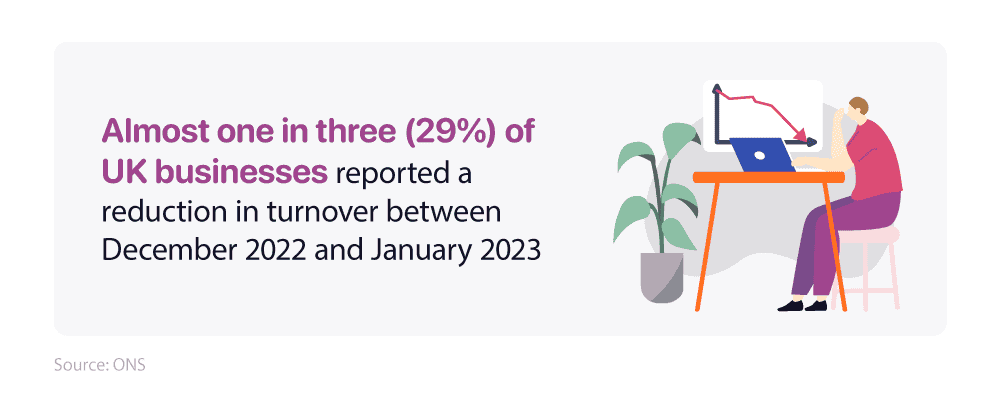
Almost four in ten (39%) of UK businesses reported an increase in the price of goods and services in January 2023 compared to December 2022. There has been month-on-month decreases in this figure since September 2022, when comparative reported figures stood at just under half (48%).
UK business cost of living stats also indicate that a quarter (25%) of UK businesses expected to increase their prices in March 2023, with rising energy costs cited as the main reason for doing so (35% of cases). Incidentally, more than a third (34%) of UK businesses admitted to passing the additional costs onto consumers within the previous six months. The most common industry to do so was manufacturing (55%).
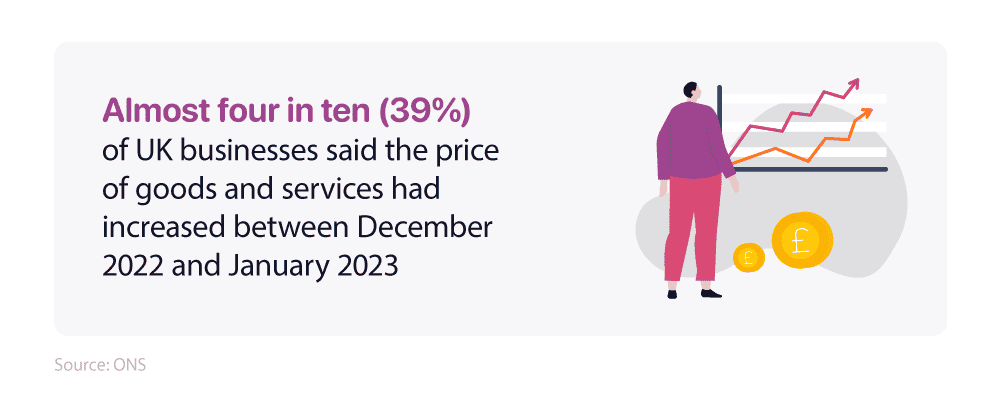
In terms of employment statistics, more than a quarter (28%) of UK businesses with 10 or more employees highlighted they experienced difficulties when recruiting new staff in January 2023.
Use our easy comparison tools to see if you could save money across a range of business finance products, including business insurance and business bank accounts.
UK energy bills for small businesses 2022 (exclusive data)
The latest projections for cost of living and business statistics show that those in the health industry saw the largest increase in their small business energy bills between 2021 and 2022.
With a 75.7% bill growth year on year, health had a larger increase in energy costs than community and leisure (74.4%), arts and culture (70.4%), hospitality (65.4%), and office spaces (62.4%).
Average cost of UK energy bills for small businesses 2022
Of all the sectors analysed, UK business cost of living stats show retail had the smallest energy bill growth, at 59.3%. This meant an average increase of £6,263.14. Due to higher overheads, those in the health industry saw the largest financial increase, with yearly energy bill expenditure at £63,629.77 on average.
A breakdown of average UK energy bills for small businesses in 2021 and 2022
(Source: money.co.uk via the Department for Business, Energy and Industrial Strategy, Valuation Office Agency, and ONS)
Offices and retail space shared markedly similar statistics in terms of small business energy bills. In 2022, the total average office energy bill was £17,846, only £1,029 more than that of average retail energy bills.
A breakdown of business energy cost statistics by business type 2021-22

| Business type | 2021 total energy bill (£) | 2022 total energy bill (£) | Estimated energy bill increase (£) | Percentage price increase (%) |
|---|---|---|---|---|
| Hospitals | 464,947 | 793,184 | 328,237 | 70.6 |
| Large food shops | 303,437 | 481,681 | 178,244 | 58.74 |
| Nursing homes | 154,550 | 262,774 | 108,223 | 70.02 |
| Large non-food shops | 104,912 | 166,368 | 61,456 | 58.58 |
| Hotels | 43,571 | 70,710 | 27,140 | 62.29 |
| Leisure centres | 33,982 | 57,937 | 23,955 | 70.49 |
| Theatres | 33,344 | 57,115 | 23,771 | 71.29 |
| Retail warehouse | 29,965 | 48,295 | 18,329 | 61.17 |
| Showrooms | 20,562 | 33,753 | 13,191 | 64.15 |
| Restaurants & takeaways | 15,958 | 25,644 | 9,686 | 60.69 |
| Pubs | 12,406 | 21,020 | 8,614 | 69.43 |
| Museums | 12,377 | 20,827 | 8,450 | 68.27 |
| Clubs & community centres | 8,931 | 15,119 | 6,188 | 69.3 |
| Offices | 7,208 | 11,709 | 4,501 | 62.44 |
| Health centres | 5,514 | 9,360 | 3,846 | 69.76 |
| Cafes | 5,891 | 9,635 | 3,745 | 63.57 |
| Nurseries | 4,016 | 6,993 | 2,977 | 74.13 |
| Small shops | 3,382 | 5,290 | 1,908 | 56.43 |
| Hairdressers | 2,582 | 4,085 | 1,503 | 58.22 |
(Source: money.co.uk via the Department for Business, Energy, and Industrial Strategy, Valuation Office Agency, and ONS)
In terms of percentage increase for all UK business industries (where data was available), nurseries yielded the largest increase in energy bills. In 2021, UK business cost of living stats show the energy bill for the average nursery stood at £4,016 a year, however 2022 saw that leap to £6,993, an increase of just under 75%.
While theatres have a smaller energy bill percentage increase than that of nurseries (71% compared to the 74% nurseries endured), their overall financial figure was a lot higher. On average, energy bills for theatres in 2021 was £33,343, however that increased to £57,114 in 2022, meaning a £23,770 year on year increase.
Hospitals suffered the most due to the surging energy bills cost seen in 2022. In 2021, the average hospital energy bill was £464,977 a year. However, in the following year, hospital energy bills shot up to an average of £793,183, an increase of £328,236 in just 12 months.
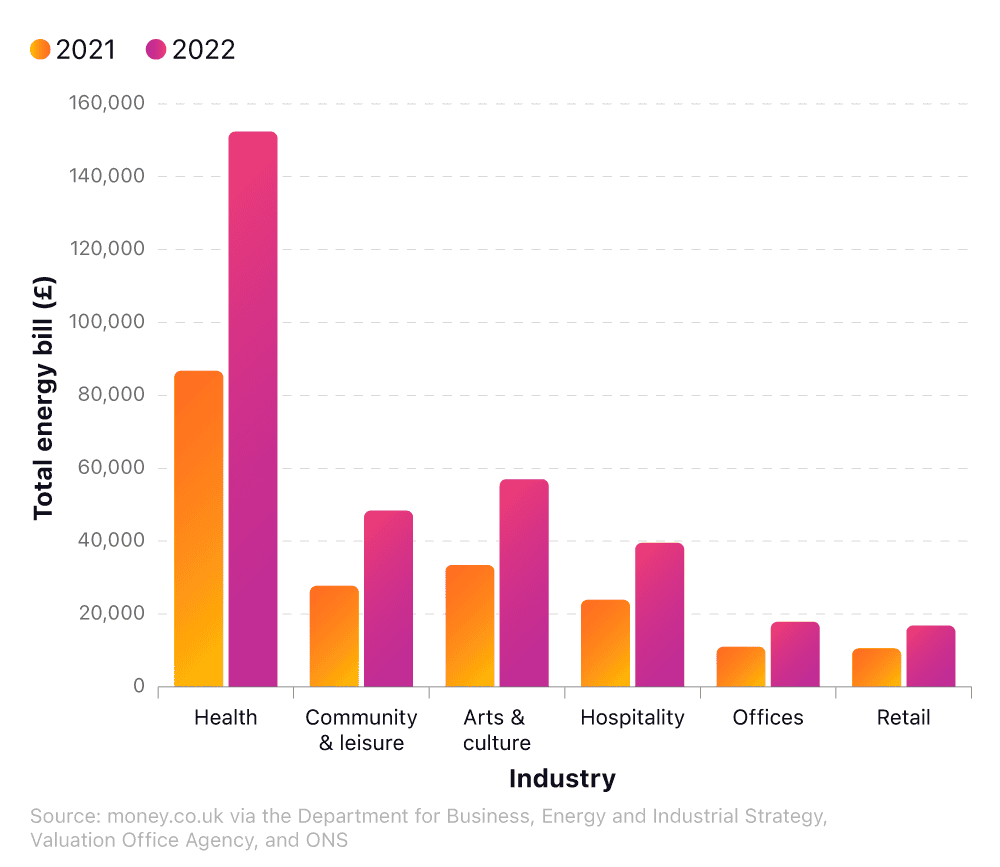
Smaller shops, such as corner shops and family-run-single-unit businesses, showed the smallest percentage increase year on year for energy bills. In 2021, the average figure was £3,381 a year on average for energy, with that figure growing to £5,289 in 2022. That’s an increase of 56.4%, a 17.7% lower rate of change than that seen by nurseries.
While smaller shops have seen the lowest percentage increase in energy bill costs, it’s hairdressers that have to pay the least per year. In 2021, on average the energy bill for a hairdresser’s premises was £2,581, with the 2022 figure increasing to £4,084. That’s £1,503 more year on year, but still represents the smallest overall growth in energy bill costs.
UK business cost of living statistics - average electricity bills
Average electricity cost for small businesses in the UK (exclusive data)
The average electricity cost for small businesses in the UK for 2022 is somewhere between £13,000 and £64,000. This figure, however, varies wildly depending on the size of the premises, the type of business and if said business is energy-intensive or not. In general, UK industries saw a 35% increase in their electricity bills between 2021 and 2022, according to our calculated UK business cost of living stats.
A breakdown of average electricity costs for UK small businesses 2022
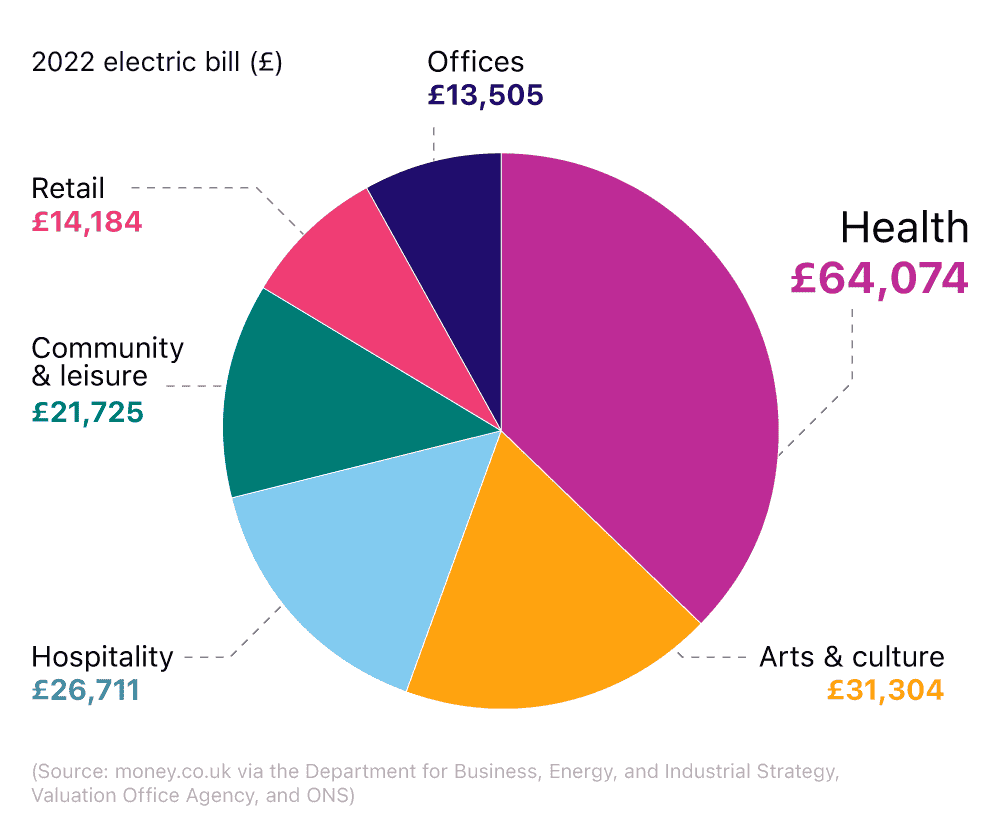
| Industry type | Average electricity use (kWh) | 2021 electric bill (£) | 2022 electric bill (£) |
|---|---|---|---|
| Health | 271,340 | 41,596 | 64,074 |
| Arts & culture | 132,564 | 20,322 | 31,304 |
| Hospitality | 113,113 | 17,340 | 26,711 |
| Community & leisure | 92,001 | 14,104 | 21,725 |
| Retail | 60,065 | 9,208 | 14,184 |
| Offices | 57,193 | 8,768 | 13,505 |
(Source: money.co.uk via the Department for Business, Energy, and Industrial Strategy, Valuation Office Agency, and ONS)
Those in the health sector consume more electricity than any other industry, at over 271,000kWh a year, more than twice that of arts and culture in second place. As a result, health-based industries will spend, on average, almost £22,500 more on electricity in 2022 compared to 2021, whereas those in arts and culture will spend just under £11,000 extra on their respective electricity bills.
![[Infographic showing average electricity costs for small UK businesses in 2022]](https://img.money.co.uk/t014ej9w3ur1/6rkMx6IZSCXpoX1utg7f1E/e58e5c3be42bd7501852eaa5b277abb6/Mini_infographic_4.png?auto=format%2Ccompress&q=45&ixlib=react-9.8.1)
Hospitality has both the third highest kWh usage across all small business types measured, with over 113,000 kWh powering the average hospitality company over 12 months. This equates to an electricity bill of £26,710 per year in 2022, £9,370 more than seen in 2021.
Offices had the cheapest electricity bills in 2022, at just over £13,500—around £4,700 more expensive than 2021. This indicates a yearly electricity usage of 57,192 kWh on average.
Thinking about starting a business? Our expert guides will provide you with key insights to help you every step of the way.
A breakdown of average electricity bill prices for UK small businesses 2022
![[IMAGE] - A bar graph showing average electricity bill prices for UK small businesses 2022](https://img.money.co.uk/t014ej9w3ur1/1uUmDPymgLXhU59nerqpoj/6d041693a2875a0a2af52919c7af31a5/A_breakdown_of_average_electricity_bill_prices_for_UK_small_businesses_2022__1_.png?auto=format%2Ccompress&q=45&ixlib=react-9.8.1)
| Business type | Average electricity use (kWh) | 2021 electric bill (£) | 2022 electric bill (£) |
|---|---|---|---|
| Hospitals | 2,146,431 | 279,895 | 431,143 |
| Large food shops | 1,791,789 | 269,127 | 414,557 |
| Nursing homes | 633,567 | 95,162 | 146,585 |
| Large non-food shops | 622,250 | 93,462 | 143,967 |
| Hotels | 227,850 | 34,929 | 53,804 |
| Retail warehouse | 161,971 | 24,830 | 38,248 |
| Leisure centres | 133,995 | 20,541 | 31,642 |
| Theatres | 127,314 | 19,517 | 30,064 |
| Showrooms | 101,515 | 15,562 | 23,972 |
| Restaurants and takeaways | 87,444 | 13,405 | 20,649 |
| Museums | 53,128 | 8,144 | 12,546 |
| Pubs | 50,982 | 7,816 | 12,039 |
| Offices | 37,524 | 5,752 | 8,861 |
| Clubs and community centres | 36,892 | 5,656 | 8,712 |
| Cafes | 29,623 | 4,541 | 6,995 |
| Small shops | 20,792 | 3,187 | 4,910 |
| Health centres | 18,871 | 3,431 | 5,285 |
| Hairdressers | 12,775 | 2,323 | 3,578 |
| Nurseries | 11,420 | 2,076 | 3,198 |
(Source: money.co.uk via the Department for Business, Energy, and Industrial Strategy, Valuation Office Agency, and ONS)
When comparing business electricity costs between different business types, hospitals had the most expensive electricity bills in 2022. Hospitals saw a rise of £151,000 by the end 2022 compared to the same period a year prior, with their electricity bill costing £431,143. The large cost was down to their high use of electricity, which on average per year was 2,146,431 kWh, 354,600 kWh more than the next highest user (large shops).
Conversely, nurseries use the least amount of electricity, with an average yearly usage of 11,420 kWh, 188 times less than that of hospitals. The 2021 electricity bill for the average nursery was £2,076, with the following year’s figure at £3,197. For comparison, the yearly figure of £3,197 would power a hospital for only 2 and a half days a year, highlighting the disparity between the two.
UK business cost of living statistics - average gas bills
Average gas cost for small businesses in the UK 2022 (exclusive data)
UK businesses saw a 49% rise in their gas bills for 2022. UK business cost of living stats show the health sector uses more gas than any other industry (almost 750,000 kWh per year). This is more than three times the amount of community and leisure-based industries in second place. Retail uses the least amount, at just over 22,000 kWh a year.
A breakdown of average gas bill for a small UK business 2022 (exclusive data)
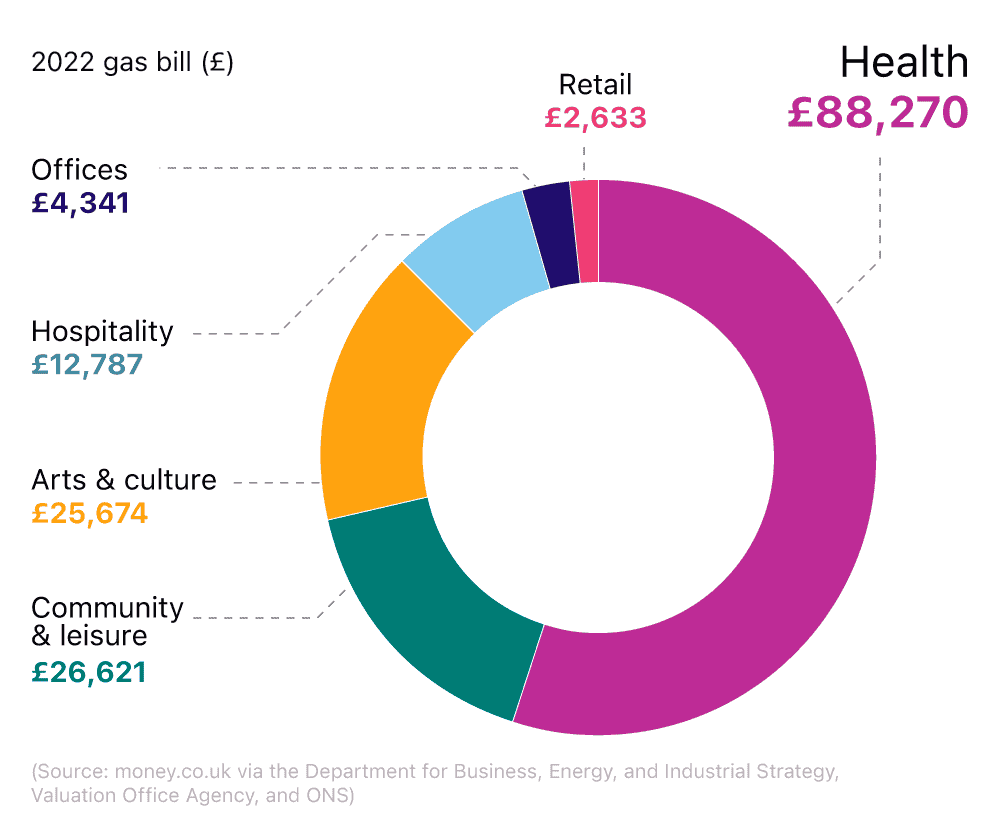
| Industry type | Average gas use (kWh) | 2021 gas bill (£) | 2022 gas bill (£) |
|---|---|---|---|
| Health | 743,301 | 45,118 | 88,270 |
| Community & leisure | 224,169 | 13,607 | 26,621 |
| Arts & culture | 216,196 | 13,123 | 25,674 |
| Hospitality | 107,676 | 6,536 | 12,787 |
| Offices | 36,552 | 2,219 | 4,341 |
| Retail | 22,175 | 1,346 | 2,633 |
(Source: Source: money.co.uk via the Department for Business, Energy, and Industrial Strategy, Valuation Office Agency, and ONS)
When comparing business gas costs, the gas bill for health industries almost doubled in 2022 to more than £88,000 a year—an additional £43,000 compared to 2021. Community and leisure, as well as arts and culture, saw their bills rise by around £12,000, to somewhere between £25,000 and £27,000 a year. Retail’s gas bill remaied the smallest, rising up to more than £2,600 a year, from just over £1,300.
![[Image - Infographic showing gas bill rises for UK small businesses in 2022]](https://img.money.co.uk/t014ej9w3ur1/CbQxKcGL3bmyfLVD5IaeO/ba8a1c383af2b1ae0ef1260903266b2f/Mini_infographic_5.png?auto=format%2Ccompress&q=45&ixlib=react-9.8.1)
Regarding gas per small business, community and leisure centres saw the largest percentage increase in average bills paid. In 2021, the gas bill was £13,607, whereas in 2022 it was £26,621. Heating large spaces such as community and leisure centres meant a per year gas bill increase of nearly 50%, as their kWh usage stretched to 224,168 on average.
Meanwhile, retail establishments will suffer the least with their energy bills. Limited gas usage meant the average 2021 bill of £1,346 increased only to £2,633.
A breakdown of average gas bill costs for UK small businesses 2022
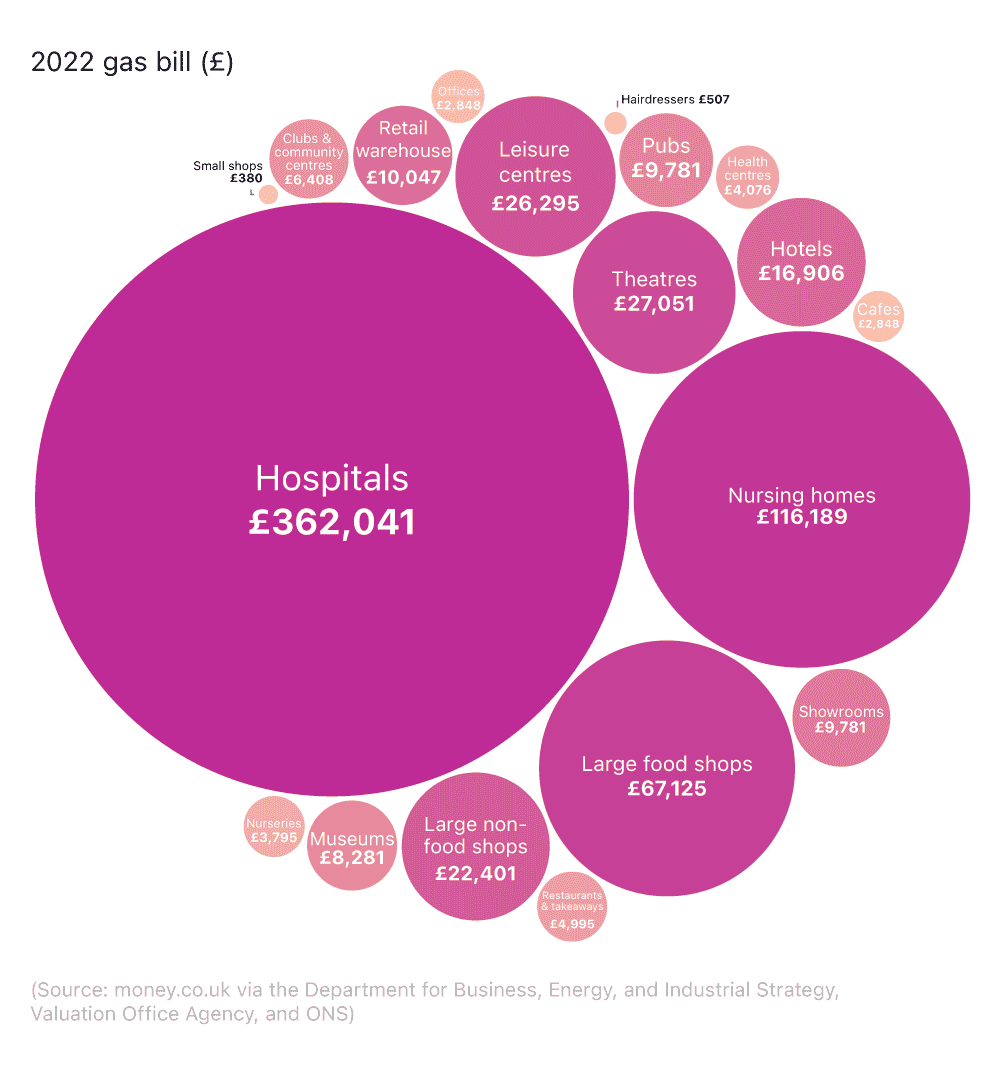
| Business type | Average gas use (kWh) | 2021 gas bill (£) | 2022 gas bill (£) |
|---|---|---|---|
| Hospitals | 6,087,262 | 185,053 | 362,041 |
| Nursing homes | 1,940,798 | 59,388 | 116,189 |
| Large food shops | 1,121,238 | 34,310 | 67,125 |
| Theatres | 227,787 | 13,827 | 27,051 |
| Leisure centres | 439,227 | 13,440 | 26,295 |
| Large non-food shops | 188,632 | 11,450 | 22,401 |
| Hotels | 282,392 | 8,641 | 16,906 |
| Retail warehouse | 84,602 | 5,135 | 10,047 |
| Showrooms | 82,364 | 5,000 | 9,781 |
| Pubs | 75,626 | 4,590 | 8,981 |
| Museums | 69,735 | 4,233 | 8,281 |
| Clubs & community centres | 53,956 | 3,275 | 6,408 |
| Restaurants & takeaways | 42,058 | 2,553 | 4,995 |
| Health centres | 34,319 | 2,083 | 4,076 |
| Nurseries | 31,960 | 1,940 | 3,795 |
| Offices | 23,982 | 1,456 | 2,848 |
| Cafes | 22,231 | 1,349 | 2,640 |
| Hairdressers | 4,271 | 259 | 507 |
| Small shops | 3,200 | 194 | 380 |
(Source: Source: money.co.uk via the Department for Business, Energy, and Industrial Strategy, Valuation Office Agency, and ONS)
When broken down by business type, hospitals top the table in terms of gas consumption, using about three times as much as nursing homes. By consuming more than six million kWh a year, their gas bills can be expected to exceed £360,000 in 2022—almost £177,000 more than in 2021.
By contrast, nursing homes (the next biggest user of gas) will see a rise of a little less than £57,000 in their 2022 gas bills. That’s down to their average gas consumption, using 1,940,000 kWh between 2021 and 2022.
At the other end of the scale, small shops use around 3,200 kWh of gas a year, costing them less than £195 a year on average in 2021. This will almost double to around £380 in 2022. For comparison, the daily gas bill for the average hospital is £991, meaning a year’s worth of gas for a small shop would fuel a hospital for just over 9 hours.
Compare rates on a range of business loans, start-up loans, and business credit cards to find the best deal for before you borrow.
Glossary of business cost of living key terms
Inflation
Inflation refers to the increase in the price of something over a given period of time. It is a reflection of a country’s cost of living and refers to the upwards trend in the cost of goods and services within the economy.
Kilowatt hour (kWh)
A kilowatt hour (kWh) is a unit of energy that refers to one kilowatt (or a thousand watts) of power that is consumed per hour. It is the most common way of measuring energy consumption within the home and refers to the amount of energy you would use if you kept a 1,000 watt appliance running for an hour.
Turnover
Turnover, in a business sense, refers to the total amount of sales made within a given period of time. Also known as income or gross revenue, business turnover is used by HMRC to determine whether a company should be registered for VAT. It differs from profit, which is a company’s total revenue (i.e. turnover) minus its expenses.
FAQ's
How is the cost of living crisis affecting businesses?
The cost of living affects businesses in a number of ways. During the cost of living crisis, consumers are likely to reduce spending habits, which means a reduction in sales for many businesses. Almost one in three (29% of) UK businesses reported such trends between December 2022 and January 2023. In addition to this, input costs are increasing, such as the cost of energy in the production stage. This means businesses either have to absorb these costs themselves, make financial cutbacks, or push the cost onto the consumer. More than a third (34%) of UK businesses admitted to pushing these costs onto the consumer in January 2023.
How does inflation affect small businesses?
UK small businesses are likely to have seen a rise in energy bills anywhere between 60-75% in 2022, with gas and electricity costs expected to have risen by 49% and 35% respectively. For small shops in particular, this could mean a rise of 56% in energy costs alone, which may have a knock-on effect for consumer prices. Either businesses will have to find ways of cutting their costs, or seeking financial support. If not, then they may be forced into absorbing these additional costs, or passing them onto the consumer by raising prices.
How are businesses helping with cost of living?
Many businesses are offering help to their employees during the cost of living crisis. Some are offering additional cash bonuses or pay rises, to help people cope with rising inflation and higher bills. For example, Virgin Media O2 announced in October 2022 they would give £1,400 to any employee earning less than £35,000 a year. Some firms are offering discounts at local businesses, such as cycle to work schemes, train fare reductions, or the option of selling back any unused annual leave. Some companies are offering a hybrid working model in order to reduce commuting costs.
What do small businesses spend the most money on?
Small businesses spend the most money on labour costs overall. It is estimated that employee wages, benefits, payroll and other related taxes can account for around 70% of a small business' outgoings, yet HR professionals only spend around 15% of their time managing the cost of labour.
Methodology and sources
https://www.ons.gov.uk/economy/inflationandpriceindices/articles/costoflivinginsights/business
https://www.gov.uk/government/statistics/energy-consumption-in-the-uk-2021
https://www.gov.uk/government/statistics/non-domestic-rating-stock-of-properties-2022
https://www.gov.uk/government/publications/building-energy-efficiency-survey-bees
https://www.ons.gov.uk/economy/inflationandpriceindices/datasets/consumerpriceinflation
https://www.paycor.com/resource-center/articles/closer-look-at-labor-costs/
UK Small Business Statistics 2022 (SMEs)
Explore our small business statistics to find out more about SME births and deaths, earnings, employment, growth and more in 2022.
Read MoreUK Diversity in Business Statistics 2023 - Facts and Stats Report
Celebrate diversity in business with our statistics on women in business, ethnic minorities, and more.
Read MoreHow to write a business plan in 10 simple steps
Follow our step-by-step guide to writing a business plan and setting your business up for success.
Read MoreCan you start a business from home?
Everyone’s heard the stories of billionaires starting their businesses from a bedroom at home, but setting up a start up takes careful planning and there are hidden costs. This is what you need to know to get it right
What you need to check forHow to fund your business idea
If there’s one thing budding entrepreneurs have in abundance it’s ideas. But great concepts often amount to nothing without the financial oomph to make them real. Here we explore how to get the money needed to earn your fortune.
Where yo look for the money you needHow to register a business?
Here’s everything you need to know to make sure your side hustle is legitimate including the difference between being a sole trader and a limited partnership, which might be right for you, and the deadlines and paperwork you need to consider
What you need to get ready nowAbout James Andrews
James has spent the past 15 years writing and editing personal finance news, specialising in consumer rights, pensions, insurance, property and investments - picking up a series of awards for his journalism along the way.






